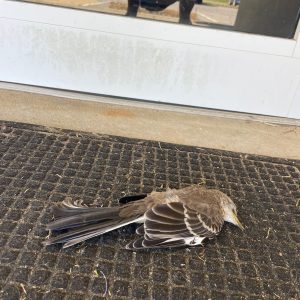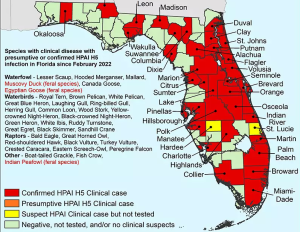
Sometimes I plan my blog subject well in advance, and sometimes the universe drops a topic literally at my feet. Walking into my office yesterday morning, I was startled to find a dead mockingbird lying on the doormat directly in front of the building door. With no visible injuries it’s hard to know what happened—perhaps it flew into the glass door and died right there where I found it? Or maybe a neighbor circling our office walking track happened upon it and left it up front, figuring the Extension office would know how to handle it. The bird may have died of old age or some common illness, or more ominously from one of the intense avian influenza strains that routinely makes its way through the bird population.

On the off chance that this poor creature did succumb to a contagious illness, I checked the Florida Fish & Wildlife Conservation Commission (FWC) website to see if they were collecting data on bird deaths. Turns out, they are—the Highly Pathogenic Avian Influenza (HPAI) virus is responsible for killing birds in 37 Florida counties since 2022. The disease, which causes neurological problems in wildlife, has also crossed taxa—the virus was identified as the cause of death for a bottlenose dolphin in Dixie County two years ago. This was only the second incident worldwide of the HPAI virus being found in a cetacean. HPAI, known more commonly as H5N1, has been devastating worldwide, killing millions of birds, then cattle and countless seals and sea lions in North & South America.
In Florida, the HPAI virus has been identified predominantly in vultures, waterbirds, and a handful of raptors like owls and eagles. We periodically take calls from people who come across dead birds out in the wild and wonder how or if they should report them. If the bird’s death is not evident, (predatory attack, vehicle strike, etc.), you may want to share the information with FWC. So, I’ll walk you through the simple process.

 At the FWC “avian mortality” reporting website, they’ll ask you to enter basic information like name/email/phone number. There’s a map feature where you can enter an address, then move a little crosshair icon to a more specific location where the bird was found. From there, you can upload photos and add any comments. The site also asks for species, and has a drop-down menu based on bird type (raptor, songbird, shorebird, etc.) There are shadowed outline shapes that can help you narrow down the general bird category, if you’re uncertain of common or scientific name.
At the FWC “avian mortality” reporting website, they’ll ask you to enter basic information like name/email/phone number. There’s a map feature where you can enter an address, then move a little crosshair icon to a more specific location where the bird was found. From there, you can upload photos and add any comments. The site also asks for species, and has a drop-down menu based on bird type (raptor, songbird, shorebird, etc.) There are shadowed outline shapes that can help you narrow down the general bird category, if you’re uncertain of common or scientific name.
The whole process took me about 10 minutes to complete. The site includes a wealth of information about avian health and diseases if you’re interested in learning more.
 7
7
